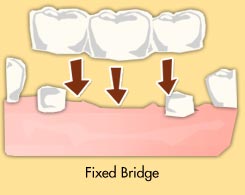Fixed Bridges

A bridge is made to replace one or more missing teeth. Bridges can be supported by natural teeth, by a combination of teeth and implants or just by implants. A traditional bridge is made by creating a crown for each tooth on both sides of the space and placing a false tooth between the crowns. The crowns can be supported by natural teeth or by implants. When the crowns are placed, the false tooth fills the space left by the missing tooth or teeth.
If the teeth receiving the crowns are healthy and strong, they probably will not need root canal therapy. However, parts of the teeth will be removed so the crowns will fit. Traditional bridges are made either of porcelain fused to metal (PFM) or ceramics.
There are other types of bridges as well. Cantilever bridges are used when there are adjacent teeth on only one side of the missing tooth or teeth. A Maryland bonded bridge (also called a resin-bonded bridge or a Maryland bridge) consists of a metal framework with “wings” on each side that are bonded to that back of your existing teeth. The false teeth are also bonded to the framework. Bonded bridges are usually not as expensive as traditional bridges because the adjacent teeth need less preparation. However, these bridges are only as strong as the bonding material and do not hold up well in areas of the mouth where the biting forces are high.
Getting a bridge requires at least two visits: the first to prepare the teeth to be crowned and make impressions, and the second to place the bridge. Bridges last at least five to seven years, often longer.
A bridge is made to replace one or more missing teeth. Bridges can be supported by natural teeth, by a combination of teeth and implants or just by implants. A traditional bridge is made by creating a crown for each tooth on both sides of the space and placing a false tooth between the crowns. The crowns can be supported by natural teeth or by implants. When the crowns are placed, the false tooth fills the space left by the missing tooth or teeth.
If the teeth receiving the crowns are healthy and strong, they probably will not need root canal therapy. However, parts of the teeth will be removed so the crowns will fit. Traditional bridges are made either of porcelain fused to metal (PFM) or ceramics.
Getting a bridge requires at least two visits: the first to prepare the teeth to be crowned and make impressions, and the second to place the bridge.


